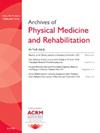Prevalence, Trajectory, and Predictors of Poststroke Fatigue in Older Adults
IF 3.7
2区 医学
Q1 REHABILITATION
Archives of physical medicine and rehabilitation
Pub Date : 2025-05-01
DOI:10.1016/j.apmr.2024.11.012
引用次数: 0
Abstract
Objective: To explore the prevalence, trajectories, and predictors of poststroke fatigue in older adults after a first ischemic stroke.
Design: A longitudinal observational cohort study.
Setting: Two hospitals.
Participants: A total of 381 patients aged ≥65 years with their first ischemic stroke were included. The mean (standard deviation) age was 71.1 (4.27) years, with 96 patients (25.2%) being women and 285 (74.8%) being men.
Interventions: Not applicable.
Main Outcome Measures: Patients were assessed using the Fatigue Severity Scale at admission, 3 months, and 12 months. Growth mixture models were used to identify distinct fatigue trajectories, and baseline variables were analyzed to determine their association with these trajectories.
Results: The prevalence of clinical fatigue was 39.11%, 33.33%, and 22.31% at admission, 3 months, and 12 months, respectively. Five distinct fatigue trajectories were identified: persistently low fatigue (class 1, 49.1%), persistently high fatigue (class 2, 21.5%), initial high but early decreasing fatigue (class 3, 15.0%), initial high but late decreasing fatigue (class 4, 8.7%), and increasing-then-decreasing fatigue (class 5, 5.8%). Multinomial logistic regression analysis revealed that several factors were significantly associated with high and persistent fatigue (class 2), including older age, lower social support, decreased physical activity, higher depression and anxiety scores, cognitive impairment, and greater stroke severity.
Conclusions: These findings indicate significant variability in the progression of fatigue among stroke survivors. Further research is necessary to determine the outcomes linked to these fatigue trajectory subgroups and to identify the most effective treatment strategies tailored to each specific subgroup.
老年人脑卒中后疲劳的患病率、轨迹和预测因素。
目的:探讨老年人首次缺血性卒中后卒中后疲劳(PSF)的患病率、发展轨迹和预测因素。设计:纵向观察队列研究。环境:两家医院。参与者:共纳入381例年龄≥65岁的首次缺血性卒中患者。平均(SD)年龄为71.1(4.27)岁,女性96例(25.2%),男性285例(74.8%)。干预措施:不适用。主要结果测量:患者在入院、3个月和12个月时使用疲劳严重程度量表(FSS)进行评估。使用生长混合模型(GMM)来识别不同的疲劳轨迹,并分析基线变量以确定它们与这些轨迹的关联。结果:患者入院时、3个月时、12个月时的临床疲劳患病率分别为39.11%、33.33%、22.31%。确定了五种不同的疲劳轨迹:持续低疲劳(类别1,49.1%),持续高疲劳(类别2,21.5%),初始高疲劳但早期减少疲劳(类别3,15.0%),初始高疲劳但后期减少疲劳(类别4,8.7%),以及先增加后减少疲劳(类别5,5.8%)。多项逻辑回归分析显示,有几个因素与高度和持续性疲劳(2类)显著相关,包括年龄较大、社会支持较低、体力活动减少、抑郁和焦虑评分较高、认知障碍和中风严重程度较高。结论:这些发现表明卒中幸存者疲劳进展的显著变异性。需要进一步的研究来确定与这些疲劳轨迹亚组相关的结果,并确定针对每个特定亚组的最有效的治疗策略。
本文章由计算机程序翻译,如有差异,请以英文原文为准。
求助全文
约1分钟内获得全文
求助全文
来源期刊
CiteScore
6.20
自引率
4.70%
发文量
495
审稿时长
38 days
期刊介绍:
The Archives of Physical Medicine and Rehabilitation publishes original, peer-reviewed research and clinical reports on important trends and developments in physical medicine and rehabilitation and related fields. This international journal brings researchers and clinicians authoritative information on the therapeutic utilization of physical, behavioral and pharmaceutical agents in providing comprehensive care for individuals with chronic illness and disabilities.
Archives began publication in 1920, publishes monthly, and is the official journal of the American Congress of Rehabilitation Medicine. Its papers are cited more often than any other rehabilitation journal.

 求助内容:
求助内容: 应助结果提醒方式:
应助结果提醒方式:


